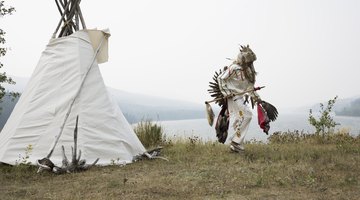Before the Europeans set their sights on the United States, there were Native Americans who lived on the land. In each state, certain Native American tribes were more powerful than others and fought for their right to the land against each other and against colonizers. Although many, unfortunately, were killed or forced out of their homes, their legacy lived on. In the state of Ohio, there were several different Ohio Indian tribes: some that were native to the area and some that moved in from other parts of the country. Those tribes are still very much alive today even though they are in much smaller numbers and have built their communities in different states. The six main Native American tribes in Ohio may share some very similar aspects with one another, but they have their differences as well.
Tip
The six Indian tribes that became the most influential in Ohio's history are the Shawnee, Delaware, Ottawa, Miami, Wyandot and Seneca-Cayuga.
About Native American Tribes in Ohio
Though Native Americans have been living in present-day Ohio for thousands of years, the terms we use to discuss Indian tribes in the area refer to those living there within the last few hundred years when the Europeans came over and the Americans took over. First and foremost, it's important to understand that Ohio was not what it is today at the time. This area encompassed both present-day Ohio, neighboring states and parts of Canada. Since humans have always been migrating, the tribes that could be found in Ohio changed frequently over time. As some groups were forced out, others came in and claimed the territory, and others banded together.
From the Iroquois- and Algonquin-speaking peoples, many different tribes were birthed in Ohio. While there are dozens and dozens of tribes from this region of the United States, there are more or less six tribes that became the most influential in Ohio's history.
1. The Shawnee Tribe
The Shawnee Tribe was one of the largest tribes in Ohio. It's believed that the Shawnee were ancestors of the Fort Ancient peoples who were in Ohio before the Iroquois came, tracing back to around the 1600s. Many were driven out, but when the Iroquois became weaker, those remaining moved back in. They were recognized for their bold resistance to the Europeans and then later the Americans. In fact, the name "Tecumseh" might stick out as someone about whom you learned in primary school, for he was a prominent individual who fought against the white settlers for the tribe.
From the Shawnees, we can learn a lot about how various Native American tribes lived in Ohio. For instance, if you've ever wondered about the homes in which the Shawnee lived, their style of home was called a "longhouse" and could hold many families in one unit. The Shawnees speak the Algonquian language. After being forcibly removed from Ohio, today their headquarters is in Oklahoma. However, there is a group in Ohio known as "United Remnant Band of the Shawnee Nation" that is not recognized by the state.
2. The Delaware Tribe
Similar to the Shawnee, the Delaware Tribe, also known as the Leni Lenape, were Algonquians and therefore had a lot in common with the Shawnee. The Delaware Tribe was originally from modern-day New Jersey and Delaware. They came to Ohio around 1700, settling there as Europeans were arriving on the East Coast and forcing tribes away from the area. When they came to Ohio, some settled along the Muskingum River, and some settled along the Auglaize River. Though they were separated, they fought together against the Iroquois and with the Shawnee against the settlers. However, some eventually became close with the French due to the fur trade, and the tribe became divided again during the American Revolution. When the Americans won, they defeated the Delaware and forced them to resettle elsewhere.
3. The Ottawa Tribe
Like the Shawnee and Delaware, the Ottawa speak Algonquian and were therefore closely related to these tribes and the Miami Tribe as well. They came from the area surrounding modern-day Ottawa on the Ottawa River in Ontario, Canada and eventually settled a little more south, arriving in northwestern Ohio in 1740. This tribe was known for organizing the Pontiac Rebellion against the British, which was unsuccessful. Today, the Ottawa tribes are not recognized anywhere in Ohio but instead in Oklahoma and Michigan, as they were forced out of the state.
4. The Miami Tribe
The Miami Tribe is the other main Algonquian tribe from Ohio, closely related to the Shawnee, Delaware and Ottawa. They arrived in Ohio in 1700, having already claimed land in many different areas around the region in Indiana, Illinois and Michigan. It's easy to see why they were considered the strongest tribe in Ohio.
The Miami Tribe learned how to survive by developing close relationships with French and British traders when it made sense for them, trading their valuable furs for goods like gunpowder. During the French and Indian war, they joined up with the French until they were defeated. Then, they allied with the British because like other Native American tribes, they were afraid of white American settlers taking their land. This, of course, is eventually what happened, and the Miami Tribe was also moved out of Ohio, today being recognized in Oklahoma and Indiana.
5. The Wyandot Tribe
The Wyandot Tribe of Ohio was yet another tribe whose fate was determined by the powerful Iroquois despite the fact that they were related to them. Originally from the Huron Tribe in Ontario, Canada, the Wyandot Tribe moved forcibly into Ohio around 1740 after the Iroquois pushed them out. Though they were from a family of tribes that spoke Wyandot and Iroquois, they had close relationships with other tribes in the area like the Shawnee. Similar to the Miami Tribe, they became close with French and British traders until the British took power, at which point they allied with them to fight against the Americans. Even though the Wyandot Tribe was remembered as being strong warriors, they were defeated by General Anthony Wayne. However, they were the last remaining Native American tribe of this capacity in Ohio. Today, the Wyandot tribes are recognized in Canada, Michigan, Kansas and Oklahoma.
6. The Seneca-Cayuga
The Seneca-Cayuga Tribe was originally the Seneca Tribe, one of the six tribes of the Iroquois Confederacy. The Seneca came to Ohio around the 1740s and 1750s from upstate New York around the time of the Beaver Wars, ultimately leaving the Iroquois Confederacy and later joining the Cayuga. Though this tribe is commonly referred to as "Mingo," this term has been used interchangeably to refer to any one of the six tribes that made up the Iroquois Confederacy, including the Seneca and Cayuga, and is technically politically incorrect. The members of what is now the Seneca-Cayuga Tribe often fought off other Native American groups as they settled in Ohio, but today, the name "Seneca-Cayuga" encompasses many different Native American groups that joined the Seneca. Today, they are recognized in New York and Oklahoma.
Native American Reservations in Ohio
Unfortunately, because all of these tribes were eventually forcibly removed from Ohio either by other Native American tribes or the Americans, there are no Native American reservations in Ohio today. The ancestors of these tribes now live in different states, though they can trace their roots back to Ohio. Because of what happened to them, it is extremely important for Americans today to learn about American Indian history.
Related Articles
References
Writer Bio
Hana LaRock is a freelance content writer from New York, currently living in Mexico. She has spent the last 5 years traveling the world and living abroad and has lived in South Korea and Israel. Before becoming a writer, Hana worked as a teacher for several years in the U.S. and around the world. She has her teaching certification in Elementary Education and Special Education, as well as a TESOL certification. Hana spent a semester studying abroad at Tel Aviv University during her undergraduate years at the University of Hartford. She hopes to use her experience to help inform others. Please visit her website, www.hanalarockwriting.com, to learn more.











